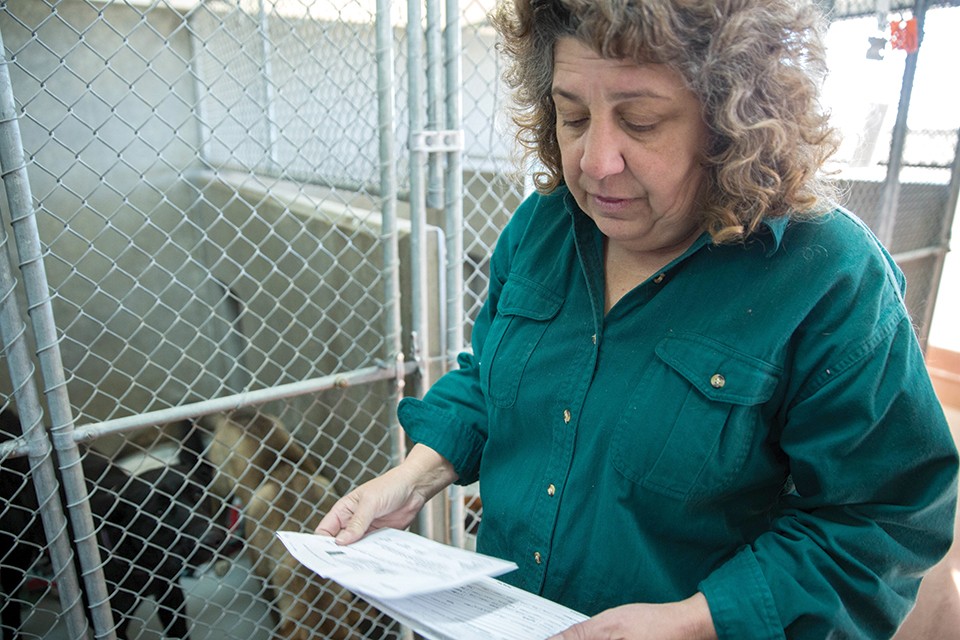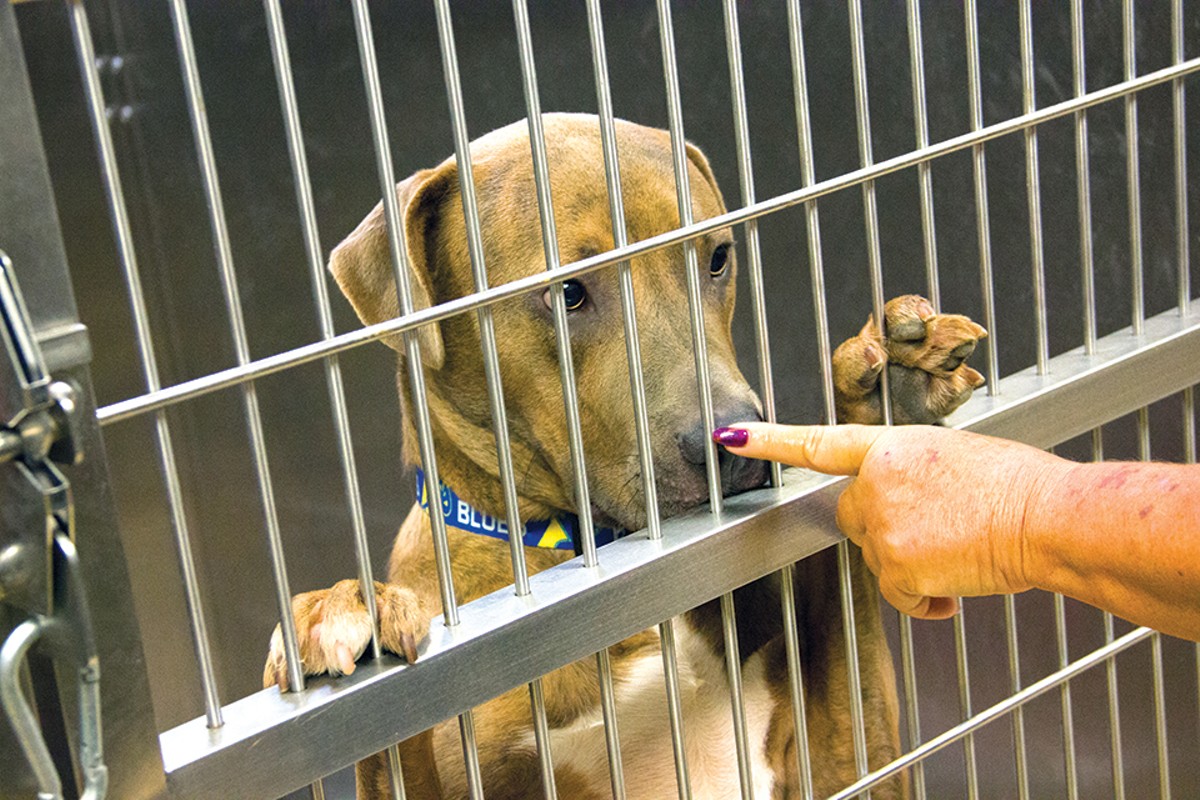
Vesco-Mock may have been traumatized by her firing, but for the shelter employee who had been among the group she called out in the hallway for "gangbanging," the firing was a relief. The shelter, he says, couldn't take any more of Vesco-Mock.
"We didn't put animals down. We held animals for months, almost a year. It was getting too full, and that's when diseases start breaking out," he recalls. "When she left, we were happy. We started to change things back to the way things were. It's taken us a while to get back."
And yet, it also appeared that Vesco-Mock's policies didn't end with her firing. After the dust had settled, Stenger appointed as interim director one of his own policy advisers, Katerina Utz, who had no experience running a shelter. Although Vesco-Mock was gone, employees who protested the ORE policy say their supervisors were still unable to get Utz to shut it down. The ORE policy persisted throughout the rest of 2018 and into 2019, halting only after auditors witnessed people initialing "ORE" on animal intake forms, even though they had no idea what it meant and didn't ask for their animals to be put down.
Not everyone cast Vesco-Mock as the villain of St. Louis County's shelter. Ellen Lawrence, the advisory board member who defended Vesco-Mock before her firing, blames Stenger for the pressure to deliver impressive euthanasia statistics, no matter the cost.
"I felt she really was treated really unfairly," Lawrence says in an interview. She claims that Vesco-Mock had in fact opposed the ORE policy and wanted it stopped but had never been allowed to make organization-wide changes. Lawrence, who serves as an elected councilwoman in Creve Coeur, acknowledges that Vesco-Mock had also brought "a lot of baggage" to the shelter.
"She wasn't a perfect director, which is an incredibly difficult position," she says. "She wasn't given the support she needed."
Even Pamela Hill, the advisory board member who lambasted the shelter's director for the staff's lack of "urgency," says in an interview that Vesco-Mock is miscast as a shelter wrecker. To Hill, the shelter's problems existed long before she arrived from New Mexico as director.
Hill notes that, beyond Vesco-Mock's firing, the details of the damning audit changed little about the way the shelter holds itself accountable, in the sense that it still does not. No one else at the shelter has been fired or disciplined.
"Put the blame where it belongs," Hill says. "The only name people say is, 'Beth did this, Beth did that.' She was in place all of seven months, and we're talking about four-and-a half years of downfall of the shelter. Now, we're being told that these things happened to us because of 'dysfunction,' so no one gets held responsible."
About a year after firing Vesco-Mock, Stenger was also gone. Federal prosecutors who had been tracing political donations to the county executive charged him with three federal felonies, and he quickly pleaded guilty. He's now serving a 46-month sentence in a federal penitentiary in South Dakota.
When the indictment against Stenger was unsealed in April, Vesco-Mock shared a local news story of the case in a public post to her Facebook page. She added only one word of heavily punctuated commentary: "BITTERSWEET!!!!!!!!!!"

During a recent visit to the St. Louis County Pet Adoption Center, the volunteers are out walking the dogs, the routes taking them past the large metallic paw prints that decorate the brick wall leading to the entrance. Inside, the kennels are filled with noisy dogs, most of them pit bulls with names like "Dolph" and "Marco."
A staff member, acting as tour guide, notes that the shelter's adoptable animals — 62 dogs and 40 cats as of October 7 — represent only a fraction of the shelter's current population. She sees goats, pigs, even exotic animals brought in by animal control officers. That's the "control" part of the county's department of Animal Care & Control. As an open-admission municipal shelter, the shelter has to take everything that comes through the front door.
The challenge of meeting both goals, care and control, has stretched the county's patience, and one solution to the problem, privatizing part of the operations, has split the shelter's supporters. But from the perspective of the county, there is a good case to be made for giving up on the government running a shelter.
Spring Schmidt says the time has come for the county to recognize that it's not doing the shelter any good to keep a broken system in place. In an interview at the Department of Public Health's administrative headquarters in Berkley, she says it is true that the advisory board, volunteers and staff all show genuine passion for animals. But they have yet to prove that the shelter can become more than a revolving door for upper management.
"We're caught between the functions the community expects of us [and] the need for credibility from the community to believe that we have the capacity to do it."
It's a bind that's led Schmidt and other county officials to consider privatizing the "care" part of the county's Animal Care & Control. The model would be similar to that of St. Louis City, which in 2019 signed a $694,000 contract with a nonprofit to take over adoption services, though the city kept its own force of animal control officers.
It is likely that a contract to take over the county's adoption services would be even larger. In 2018, the county shelter took in more than 4,000 animals, four times the amount of intake reported by the city. The county's 2019 budget reserved $1.7 million for Animal Care & Control, with most of the funds going to shelter staff and services. Around $350,000 is reserved to pay the salaries of ten animal control officers.
It was the audit that first suggested a new direction for the shelter. A section buried on the audit's second-to-last page featured a list of "other models" for operating municipal shelters, a list that included "All Field Operations Provided by Local Government; All Shelter Operations Provided by Non-Profit."
During the September 19 advisory board meeting, Schmidt announced that the county had begun drafting plans to identify bidders through a formal request for proposal, or RFP. After that, Schmidt estimated, "a good scenario is six months to contract completion," adding that "a nightmare is everything past that."
During the meeting, Schmidt told the board that she expected the Department of Public Health to present its RFP proposal during the county council's September 24 meeting. However, the status of the department's privatization push is suddenly murky. The meeting came and went without action on the shelter. So did the next meeting.
In an October 2 email, Department of Public Health spokeswoman Sara Dayley told RFT, "No RFP has been released currently and DPH does not yet have a timeline for such."
For the shelter staff, however, the impact has already hit home. Some have already taken new jobs in other county departments. If a nonprofit does take over, employees may soon find themselves, at best, forced to reapply to their own jobs, or seek their fortune elsewhere in non-animal care.
Dr. Christine Schultz decided not to wait around to find out. Hired as a veterinarian for the county shelter in late 2018, she tells RFT that she quit in August to take a job with the nonprofit Stray Rescue, "directly because of Spring telling us they were going to privatize."
"I love shelter medicine, and I can certainly deal with the outside frustrations," she says. "But if you're going to tell me you're going to give away my job? Once they started talking about privatization, I knew. If there's any possible way to do it, they will do it as fast possible."
The county shelter has long struggled to maintain a full-time veterinary staff, and Schultz's departure left a patchwork system even patchier, with one part-time vet conducting spay and neuter surgeries, and a second vet signed under an "emergency contract" which makes them available for surgery only a couple times per week.
Doing more with little, though, is nothing new for the county shelter. When Schultz began her duties there in 2018, she says the crowding was so high that on some days she would be required to check on more than 400 animals — which gave her about 80 seconds per animal.
Schultz says the shelter's outreach efforts aren't doing enough to curb overpopulation, but she still bristles when asked about criticism directed at staff by the shelter's advisory board members, especially the critiques aimed at the employee "culture" and lack of "compassion."
"When the population is this high, I know staff members who get to work an hour early," she says. "That's what everybody does there to get things done."
The underlying tensions threaten to strangle the shelter, and Schultz says that while the board and county officials have put thought into an exit plan, they could still do something to fix the situation on the ground — hire a director, improve the outreach, provide job security. Anything.
"That's just what they say at these meetings — that animal control is a blemish," Schultz says, "That's how the Department of Public Health sees it."






